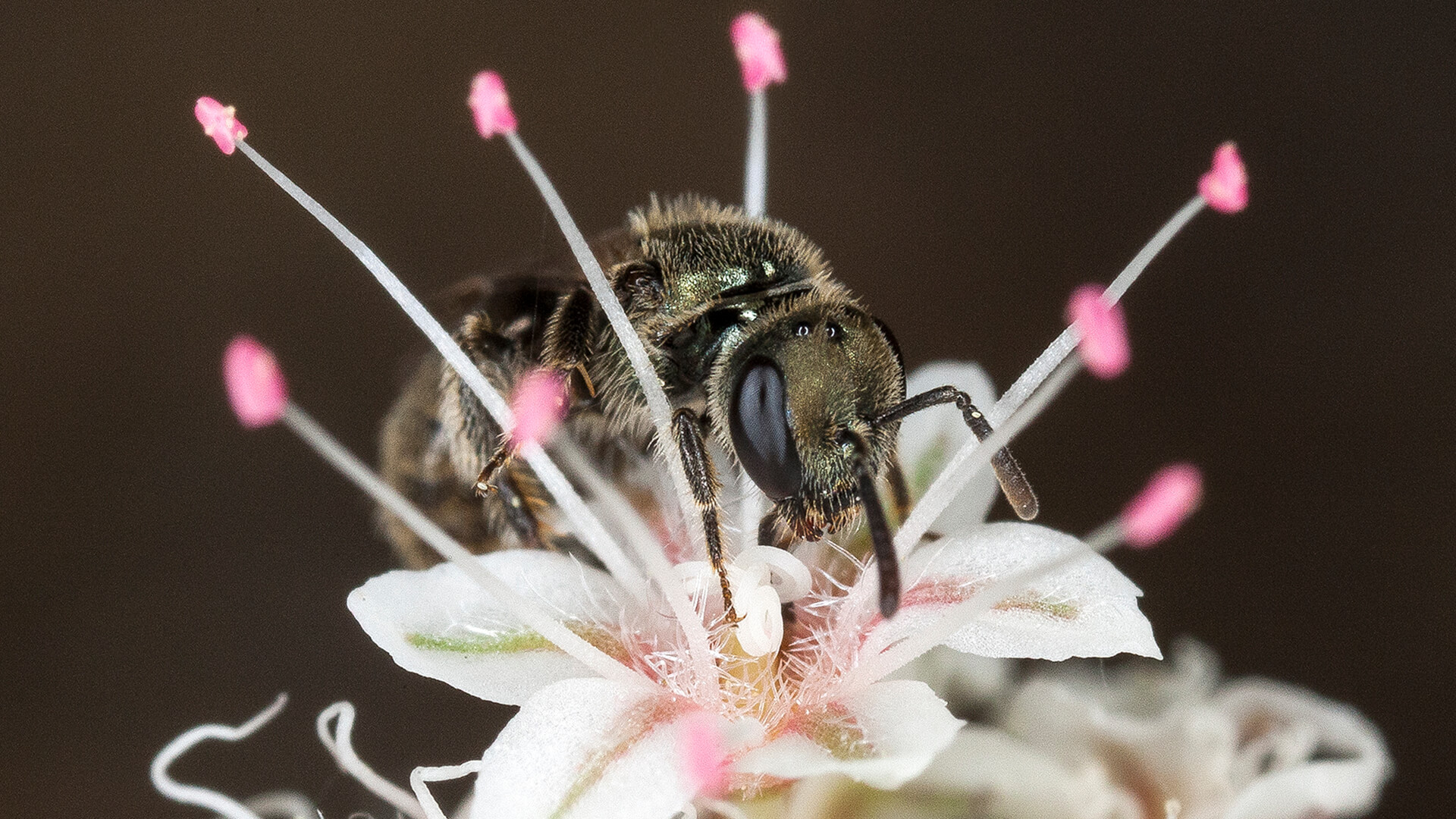
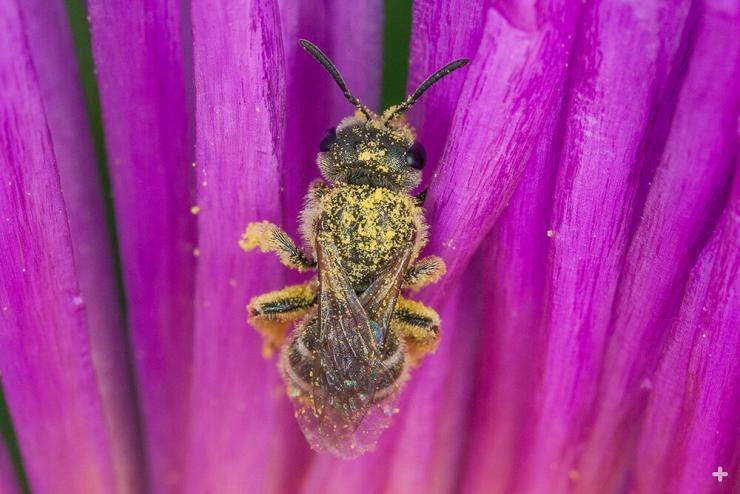
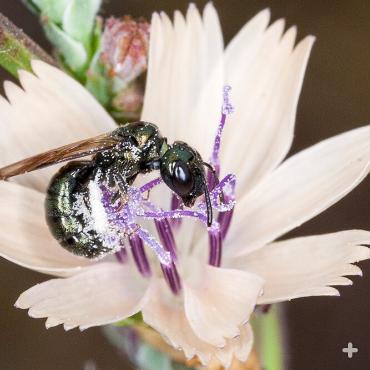
ABOUT
Sometimes you hear them before you see them. You may even be afraid of them. But the more you know about bees, the more you can appreciate these unique insects and how they provide humans with more than just honey!
Bees can be black, brown, or striped with white, yellow, or orange. All bees are covered with hair, but some have more hair than others. They are specialized insects called pollinators that collect nectar and pollen from flowers. As pollinators, they play a very important role in ecosystems worldwide.
Cultivated or native? When we talk about bees, we often think of honey bees. They create the honey we eat and the beeswax we use to make candles and other products. Honey bees are considered “cultivated bees,” because people who want to use them to produce honey and beeswax often bring them to an area from another part of the world.
But did you know that there are more than 4,000 types of “native bees” in the United States? Native bees are species that have always lived in an area and can survive without human help. These bees do not produce honey or beeswax that we can use, but they do pollinate many of our crops and food crops. They do this so much that they are called “super pollinators”.
Pollen capacity. The bees are very similar to the predatory bees of millions of years ago. But when flowering plants appeared on Earth, bees became vegetarians, eating only nectar and pollen taken from flowers. Pollen is a balanced food with many essential nutrients that bees need to survive. Female bees have a structure in their legs that no other insect, including wasps, has: pollen baskets. The basket is made from rows of curved bristles that form a hollow space on the outside of the bee’s leg, usually the bee’s hind leg. When a bee visits a flower, it brushes pollen grains into its basket. Pollen also sticks to bee hair.
Male bees do not collect pollen so they do not have this special body part. Leafcutter bees carry pollen in bristles on the underside of their abdomen. And some species, such as parasitic wasps, do not have pollen baskets.
What about nectar? Bees have a special tongue to suck up sweet nectar and have a mouthpiece in their throat to store it until they return to the hive. Here the nectar is turned into honey. Bees can store large amounts of honey in their hives to use as food.
ENVIRONMENT AND DIET
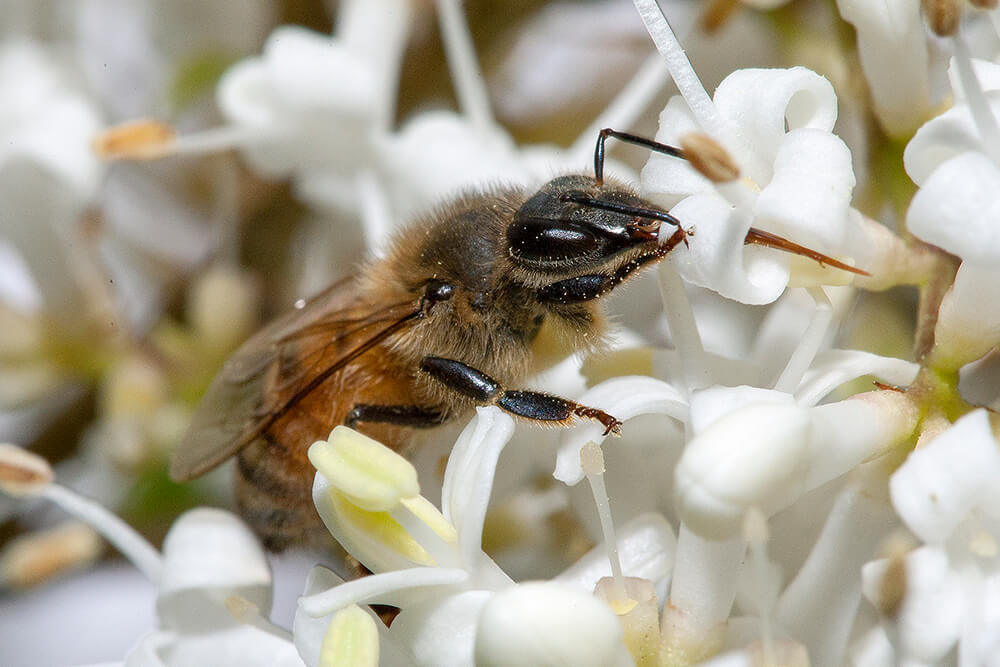
All the bees fly from flower to flower, sipping nectar and collecting pollen grains. Many plants depend on bees to spread pollen, which helps them reproduce. Flowers that attract bees are usually yellow, blue and purple. Many bees specialize in a particular type of plant. In areas where different flowering plants bloom at the same time, this keeps different species of bees from competing for the same flowers!
The fruits and vegetables we love to eat like oranges, tomatoes and squash require bees to distribute vital pollen. When these crops are ready to flower, farmers often hire commercial beekeepers to introduce bees to their fields. Beekeepers place hives near fields for several weeks. Bees harvest pollen and nectar for their hives, and plants are pollinated in the process.
Bees are also important in keeping food for humans. We can thank bees for many products that humans use:
Fruits and vegetables: Think of the bees as you enjoy almonds, apples, avocados, blueberries, cherries, cranberries, cucumbers, kiwis, melons, peaches, pears, plums, strawberries , sunflower seeds, watermelon, etc. These items are all the result of bee pollination!
Honey: Who doesn’t like the sweetness of honey? Honey can also have different flavors and colors, depending on the type of flower the bees used to collect the nectar. For example, there is clover honey, orange blossom honey, sour honey and buckwheat honey.
Beeswax: Candles made from beeswax give off a honey-scented light and burn cleanly and brightly. Beeswax is also used as hand lotion, furniture polish, and candy coating (like on jelly beans!).
It’s a productive world for bees: Bees can be both remarkable and fascinating to view from afar! Give them space and they will continue their work supporting the reproduction of flowering plants and bringing us tastier fruits and vegetables, PLUS fewer pests and a Healthier living environment!
FAMILY LIFE
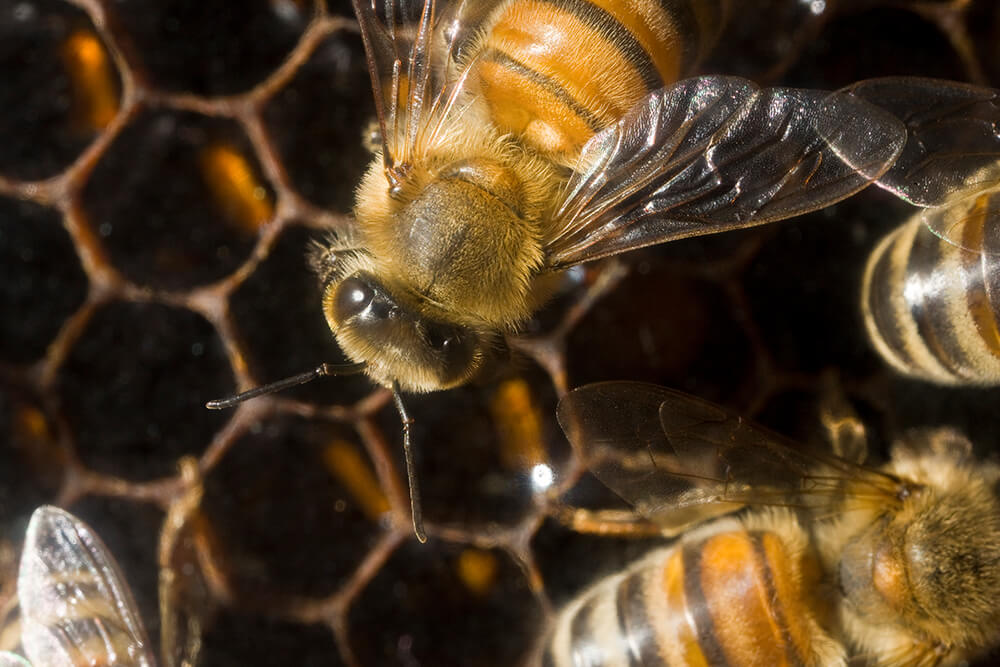
Most bees live alone and do not form hives. Each female builds her nest in holes found in dead wood, tree hollows, snail shells or crumbling walls. Some build nests on rocks or bushes, using mud, chewed leaves, and animal hair. Eggs are laid on pollen in the nest. Parasitic bees lay eggs in the nests of other bees. Their larvae feed on pollen and honey intended for the host’s larvae!
Solitary bees rarely sting. In fact, male bees don’t even have stingers, and female bees’ stingers aren’t long enough to penetrate your skin. Solitary bees do not have a “backup” like honey bees, nor do they have a nest to protect, so they are less likely to sting. Instead of producing honey, they create a food called “bee cake” by mixing pollen and nectar. The female fills the pollen basket and brings the pollen back to the nest to make a batch of bee cakes for the children.
Honeybees and bumblebees are social. They live in colonies that include fertile queens, sterile worker bees, and males called “drones.” These social bees are the only bees that produce and store honey.
Honeybees, bumblebees, and some native bees live in colonies or hives. All bees work together for the benefit of the hive. No honeybee or bumblebee can survive on its own for long. Each person has a job to do:
Queen: From her title, it seems like the queen holds the power, but she actually has very little power within the hive. Her sole job is to lay eggs—up to 2,000 per day for 2 to 5 years! The worker bees control the number of eggs she lays by the amount of food they feed her.
Worker bees: Most of the other bees in the hive are also female. They are called “workers” and with good reason! They build beehives, care for the larvae, clean the nest, feed the queen, and collect food. There are thousands of worker bees in a colony, sometimes up to 60,000 bees! Their jobs change as they get older.
A newly hatched bee does the cleaning work for the first three days. The young bees then act as nurses, raising the larvae and the queen bee. At about day 10, when the wax glands mature, it becomes a mason, building honeycombs. From about the 16th to the 20th day, the female bee receives pollen and nectar brought back to the nest by the old bee and puts it into the nest. For the next few days she will guard the hive. Near the end of her life, she became a food collector. She flies back and forth for the remaining weeks to collect as much nectar and pollen as possible for the hive.
Drones: These are the few males that hatch in the nest. They spend the first days after hatching being fed by their sisters before flying off to find the queen. The drones have big eyes that help them find the queen. Only the fastest drones will catch the queen and have a chance to reproduce. When a drone captures the queen and successfully mates, she dies.
“Talking” bees: Worker bees inform others in the colony about new food sources by leaving a scent trail between themselves and the nest. Honeybees share this information by “dancing.” The bee that finds the new patch of flowers carries the pollen sample back to the hive, where it shakes and wiggle its tail, spreading the floral scent to the others. Some scientists believe that the way she moves tells the others which direction her food is going. Others believe that she only deflects scent so other bees know which scent to look for. Either way, the bee gets her message and soon other bees will start searching for the delicious nectar.
Inside the hive, hang honeycomb panels made by bees to protect the larvae and store their pollen and honey. Honeycomb is made from beeswax secreted from glands on the abdomen of worker bees. Workers chew the wax and mold it into six-sided honeycomb cells, which together form a honeycomb panel 2 to 4 feet (0.6 to 1.2 meters) long. An empty honeycomb weighs only a few ounces (grams), but when filled with honey it can weigh many pounds (kg).
Killer bees: There has been a lot of hype about so-called killer bees, starting with that scary name. The correct name is African honey bee (AHB). In 1956, African honey bees were brought to Brazil and crossed with local honey bees to create hybrid bees to increase honey production. Unfortunately, these new hybrids are very aggressive. This is not a desirable situation for beekeepers! Some AHB queens have escaped from Brazil and AHB has gradually spread north through South America, Central America, eastern Mexico and now the United States.
AHBs look exactly like regular honey bees, but they function a little differently; They are more aggressive and quicker in defending their hives. These bees chase their enemies over longer distances and they tend to group and sting in large numbers. When a person is stung multiple times, it can be dangerous. But a sting from an AHB is no more dangerous than any other bee sting.
CONSERVE
You may have heard of Colony Collapse Disorder (CCD), the rapid loss of entire honey bee colonies. A significant decline in these pollinator populations could seriously damage our food supply. The cause of this decline is unclear, but it is believed to be the use of pesticides, the types of crops grown, diseases caused by mites and fungi, as well as the pressure of moving hives long distances for farming. Evenly planted can harm honey bee populations. It seems that beekeepers who raise bees organically and keep them in long-term apiaries do not encounter many difficulties.
Fortunately, CCD does not affect native solitary bees. This is good news for us. If honeybees can no longer meet our pollination needs, native bees can be raised to supplement or replace them. Studies have shown that just 500 green garden bees can do the work of 40,000 honey bees! There are many more questions to be answered and research is still underway, but it’s nice to know that the native bees we often take for granted may one day play an even more important role. even greater in our survival.
What can you do for bees? Try to avoid using pesticides. Plant a variety of native plants in your garden. Provide a place for bees to nest and lay eggs. Provide sheltered, undisturbed areas where native bees can hibernate or overwinter. No yard or garden? No problem—you can still be part of the solution by installing an inexpensive “bee block” for solitary bees to nest.





